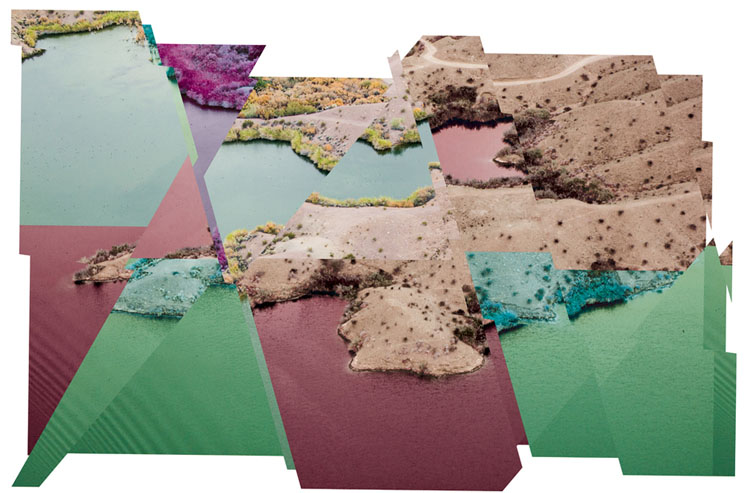Experiments in manipulating the photographic image go back to the birth of photography. Almost immediately after experiencing the wonder that the camera could reproduce the likeness of reality, photographers began to mess with that reality. It is the medium of the unreal real. We use photos as documentary evidence, just as we have learned to distrust the information conveyed by photographic image. Photography’s slight-of-hand is the illusion of objectivity.
So let’s get this obvious statement out of the way: the internet, digital technology, camera phones, security cameras, drones, Instagram, and all the rest of it continue to affect and change the way we make, process, interpret, and experience images.
That’s the jumping off point for A Flexible Arrangement, an exhibition at Gray Matters curated by artist Nathan Green. What unites these artists is their interest in making art that manipulates photographic images, as well as a kind of aesthetic affinity centered on abstraction. Some of these artists – Kevin Tedora, Sterling Allen, Barry Stone, and Casey James Wilson – are trying to reconcile (or perhaps cross pollinate) painting and photography. Others – Kalee Appleton, Josh Rios – appear more interested in the photograph’s nature as document and what happens to its meaning when that is altered, foiled, or manipulated.
In a competition of variations on a theme, the most economical or efficient approaches often feel the most successful. Rios’ single contribution to the show consists of six folded photographs of Georgia O’Keefe, folded and reframed to present six distinctively new compositions. The effect both produces a new reading of these iconic images while retaining something of the residue of their original meaning and context.
Similarly, Kalee Appleton’s chopped up and reconfigured landscapes subvert the documentary character of her images—reminiscent, as all aerial photography is these days, I suppose, of drone or satellite surveillance technology. By reconstructing landscapes that may or may not be fictional representations of unreal places, real places fictionalized, or real places simply formally reconstructed and obscured by the introduction of abstract elements, she relocates the documentary character of her images on unstable, unreliable ground.
Other work in the show feels slightly less compelling if only because they mostly terminate in meditations on painterly flatness and found modernism. Casey James Wilson photographs painted brick walls or grated-up windows to create constructivist-y compositions; Kevin Todora confuses the surface and object-ness of his work by collaging photos, paint, and cut-outs and printing them on inkjet on MDO.
Barry Stone charges head-first into this blurring of digital imagery and the history of painting with large blow-up reproductions of details of Monet’s Water Lilies. The images not only mine interesting abstract compositions from the manipulation of the famous impressionist painting, but call our attention to the fact that most of the famous paintings we are familiar with we know only through digital photographic reproductions.
Along this vein, I was most entranced by Sterling Allen’s complicated studio compositions—arranged items that include photographs, shards of wood, drawings, and other colorful materials. When photographed, they create a kind abstract diorama, unified by an Easter-y pastel-y color pallet and a keenly configured (and very nostalgically 1980s) compositional scheme. It is the studio-as-Pee Wee’s Playhouse stage set, or, perhaps, Pee Wee’s aesthetic refined through an austere modernist sensibility.
Still, as someone remarked to me that night, they can look a bit like photos from a Where’s Waldo-style hidden image picture book. That unexpected, tongue-in-cheek allusion is a reminder of the ever-tricky ground of the photographic image. The photo image’s unreliable nature rests not only in its ability to be manipulated or reconfigured, but with the ease with which photos absorb or appropriate intended and unintended exterior associations and meanings.






